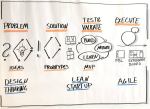“The potential of immersive technologies is not just to entertain us, but to connect us to people and experiences in ways that profoundly affect how we live, learn, and relate to each other.”
Jeremy Bailenson, Founding Director of Stanford University’s Virtual Human Interaction Lab.
Immersive Technologies are a set of technologies that enable users to be fully engaged and immersed in a digital environment. These technologies provide a sense of presence and can create the illusion of being physically present in a virtual world or augmented reality.
Types Of Immersive Technologies
- Virtual Reality (VR): VR is a technology that simulates a completely immersive digital environment, which users can experience through a headset or other wearable devices. It allows users to interact with a 3D digital world, move around and manipulate objects within it.
- Augmented Reality (AR): AR is a technology that overlays digital information onto the real world. It uses cameras and sensors to detect the user’s environment and adds virtual objects to the view, allowing users to interact with them in real-time.
- Mixed Reality (MR): MR is a technology that combines elements of both virtual reality and augmented reality. It allows users to interact with digital objects that appear to be placed in the real world, and also enables them to manipulate those objects with their hands or other physical objects.
- Xtended Reality (XR): XR Is an umbrella term that encompasses all immersive technologies, including Virtual Reality (VR), Augmented Reality (AR), and Mixed Reality (MR). XR goes beyond traditional 2D interfaces, offering a more interactive and immersive experience to users.
- Haptic Feedback: Haptic feedback is a technology that provides users with a physical sensation of touch or force feedback in response to their interactions with digital environments. It can be used in conjunction with other immersive technologies to enhance the sense of presence and interactivity.
Benefits Of Immersive Technologies
Immersive technologies, such as virtual reality (VR), augmented reality (AR), and mixed reality (MR), offer numerous benefits across a wide range of industries and applications. Here are some of the key benefits of immersive technologies:
- Enhanced User Engagement: Immersive technologies can provide users with a more engaging and interactive experience, increasing their level of interest and retention of information. This is particularly useful in education and training settings.
- Improved Learning Outcomes: Studies have shown that immersive technologies can improve learning outcomes by providing a more dynamic and engaging learning experience. This is particularly useful in fields such as science, engineering, and medicine.
- Cost Savings: Immersive technologies can save costs by reducing the need for physical training facilities, travel expenses, and expensive equipment. They can also be used to simulate dangerous or expensive situations, reducing the risk of injury or damage.
- Increased Efficiency: Immersive technologies can be used to improve efficiency by providing real-time data and insights, allowing users to make faster and more informed decisions.
- Accessibility: Immersive technologies can make education, training, and entertainment more accessible to people with disabilities, such as those who are visually impaired.
- Improved Safety: Immersive technologies can be used to simulate hazardous or dangerous environments, allowing workers to practice and prepare for real-world scenarios safely.
- Innovative Marketing: Immersive technologies can be used to create innovative marketing campaigns, such as interactive product demonstrations or virtual store tours, increasing customer engagement and brand awareness.
Overall, Immersive Technologies have the potential to transform the way we learn, work, and entertain ourselves, and their benefits are likely to continue to grow as these technologies continue to evolve
Future Trends Of Immersive Technologies
The future of Immersive Technologies, such as Virtual Reality (VR), Augmented Reality (AR), and Mixed Reality (MR), looks promising, with a number of emerging trends on the horizon. Here are some of the most significant trends to watch for in the coming years:
- Increased Adoption: As the technology continues to evolve and become more accessible, we can expect to see increased adoption of immersive technologies across a wide range of industries and applications, including education, healthcare, and entertainment.
- Advancements in Hardware: With the release of new devices such as the Oculus Quest and Valve Index, we can expect to see further advancements in hardware, including higher resolutions, wider field-of-view, and improved haptic feedback.
- Integration with Artificial Intelligence: As artificial intelligence (AI) technology continues to evolve, we can expect to see more integration with immersive technologies, allowing for more advanced simulations and interactive experiences.
- Development of New Use Cases: With the increasing adoption of immersive technologies, we can expect to see the development of new use cases and applications, such as virtual social events and remote work collaboration.
- Emergence of Web-Based AR: Web-based AR allows users to access augmented reality experiences directly from their web browser, without the need for a dedicated app. This has the potential to increase accessibility and drive adoption of AR technology.
- Growth of Location-Based Entertainment: Location-Based Entertainment (LBE) refers to immersive experiences that take place in physical spaces, such as VR arcades and theme parks. As the technology improves and more LBE experiences become available, we can expect to see continued growth in this area.
- 5G Connectivity: The widespread adoption of 5G networks will enable faster and more reliable data transfer, making it possible to stream high-quality VR and AR content without delays or lag.
- Social VR: Social VR platforms, which enable users to interact with each other in virtual environments, are becoming increasingly popular. These platforms are likely to become more sophisticated, offering more immersive and interactive social experiences.
- Extended Reality (XR) Integration: The integration of different immersive technologies, such as VR, AR, and MR, will enable users to move seamlessly between virtual and physical environments.
- Remote Work: As more companies adopt remote work, immersive technologies can provide virtual meeting and collaboration spaces that simulate in-person interactions, improving remote team collaboration.
- Healthcare: Immersive technologies have the potential to revolutionize the healthcare industry by enabling more accurate and efficient training, virtual consultations, and remote monitoring of patients.
Overall, the future trends of immersive technologies are exciting and diverse, with numerous applications in various industries, including entertainment, education, healthcare, and business. As these technologies continue to develop and become more accessible, they have the potential to transform the way we live, work, and interact with each other.
Final Thoughts
Immersive Technologies have a wide range of applications, including entertainment, education, healthcare, and industry. As these technologies continue to develop, they have the potential to transform the way we interact with digital content and the world around us.
Overall, the future of Immersive Technologies looks exciting, with new advancements and applications continuing to emerge. As the technology becomes more accessible and widely adopted, we can expect to see immersive technologies increasingly integrated into our daily lives.
🅐🅚🅖
Interested in Management, Design or Technology Consulting, contact anil.kg.26@gmail.com
Get updates and news on our social channels!
LATEST POSTS
- A Tale Of Two Frameworks: Spring Boot vs. Django
 “Spring Boot’s convention over configuration approach simplifies development, allowing developers… Read more: A Tale Of Two Frameworks: Spring Boot vs. Django
“Spring Boot’s convention over configuration approach simplifies development, allowing developers… Read more: A Tale Of Two Frameworks: Spring Boot vs. Django - Unleashing The Power Of Django
 “Django, akin to a Swiss Army knife, provides a comprehensive… Read more: Unleashing The Power Of Django
“Django, akin to a Swiss Army knife, provides a comprehensive… Read more: Unleashing The Power Of Django - Potential of Progressive Web Apps (PWAs)
 “PWAs are not just about technology; they are about creating… Read more: Potential of Progressive Web Apps (PWAs)
“PWAs are not just about technology; they are about creating… Read more: Potential of Progressive Web Apps (PWAs) - Unleashing The Power Of Spring Framework
 “Spring Framework simplifies enterprise Java development, but it does so… Read more: Unleashing The Power Of Spring Framework
“Spring Framework simplifies enterprise Java development, but it does so… Read more: Unleashing The Power Of Spring Framework - Key Trends Of OSINT In 2024
 “The future of OSINT lies in our ability to adapt… Read more: Key Trends Of OSINT In 2024
“The future of OSINT lies in our ability to adapt… Read more: Key Trends Of OSINT In 2024 - Can Google’s Carbon Language Replace C++?
 “While Carbon may excel in performance-critical domains, it cannot replace… Read more: Can Google’s Carbon Language Replace C++?
“While Carbon may excel in performance-critical domains, it cannot replace… Read more: Can Google’s Carbon Language Replace C++? - Integration of Design Thinking, Lean, and Agile
 “Innovation thrives when Design Thinking, Lean, and Agile converge, creating… Read more: Integration of Design Thinking, Lean, and Agile
“Innovation thrives when Design Thinking, Lean, and Agile converge, creating… Read more: Integration of Design Thinking, Lean, and Agile - Benefits Of Infrastructure as Code (IaC)
 “Infrastructure as Code is the single most important thing you… Read more: Benefits Of Infrastructure as Code (IaC)
“Infrastructure as Code is the single most important thing you… Read more: Benefits Of Infrastructure as Code (IaC) - Power Of Internet of Everything (IoE)
 “The true power of the Intebrnet of Everything lies not… Read more: Power Of Internet of Everything (IoE)
“The true power of the Intebrnet of Everything lies not… Read more: Power Of Internet of Everything (IoE) - How Is The Enterprise IoT Evolving?
 “IoT is not just about connecting things; it’s about connecting… Read more: How Is The Enterprise IoT Evolving?
“IoT is not just about connecting things; it’s about connecting… Read more: How Is The Enterprise IoT Evolving? - IT Pricing Strategy And Models
 “The art of pricing lies in finding the perfect balance… Read more: IT Pricing Strategy And Models
“The art of pricing lies in finding the perfect balance… Read more: IT Pricing Strategy And Models - What Is SYCL (“sickle”)?
 “SYCL provides a powerful and intuitive programming model that simplifies… Read more: What Is SYCL (“sickle”)?
“SYCL provides a powerful and intuitive programming model that simplifies… Read more: What Is SYCL (“sickle”)? - What Is A Data Lakehouse?
 “With a data lakehouse, organizations can break down data silos,… Read more: What Is A Data Lakehouse?
“With a data lakehouse, organizations can break down data silos,… Read more: What Is A Data Lakehouse? - 5G – The Future Of The Internet
 “5G is the next big step in the evolution of… Read more: 5G – The Future Of The Internet
“5G is the next big step in the evolution of… Read more: 5G – The Future Of The Internet - Ransomware Groups Are Switching To Rust
 “Rust is to Ransomware what a lockpick is to a… Read more: Ransomware Groups Are Switching To Rust
“Rust is to Ransomware what a lockpick is to a… Read more: Ransomware Groups Are Switching To Rust - Streaming Data Pipelines
 “A streaming data pipeline is like a river: it flows… Read more: Streaming Data Pipelines
“A streaming data pipeline is like a river: it flows… Read more: Streaming Data Pipelines - Why Rust Is Best?
 “Rust is a systems programming language that runs blazingly fast,… Read more: Why Rust Is Best?
“Rust is a systems programming language that runs blazingly fast,… Read more: Why Rust Is Best? - Database Sharding Explained
 “Database sharding is like breaking a large puzzle into smaller,… Read more: Database Sharding Explained
“Database sharding is like breaking a large puzzle into smaller,… Read more: Database Sharding Explained - Ambient Computing Will Be The Future Tech
 “Ambient computing creates a seamless technology-rich environment, but challenges in… Read more: Ambient Computing Will Be The Future Tech
“Ambient computing creates a seamless technology-rich environment, but challenges in… Read more: Ambient Computing Will Be The Future Tech - Key Trends Of OSINT In 2023
 “OSINT is not just a technique, it’s a mindset. It’s… Read more: Key Trends Of OSINT In 2023
“OSINT is not just a technique, it’s a mindset. It’s… Read more: Key Trends Of OSINT In 2023

